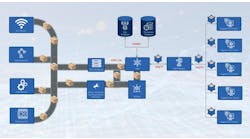How to unravel the impact of OPC UA acceptance
Dennis Christensen is business development manager—systems at Pepperl+Fuchs.
What have been the most significant advancements/changes in technology that have affected OPC UA acceptance/implementation in the past five years?
Dennis Christensen, business development manager—systems, Pepperl+Fuchs: With the acceptance of software in industrial applications, OPC UA has become the standard interface for Industry 4.0 and Industrial Internet of Things (IIoT) applications. It is an open and platform-neutral way to acquire data from industrial devices. It allows advancement and acceptance of machine visualization, digital twins and machine learning.
What’s the most innovative or efficient OPC UA application you’ve ever seen or been involved with?
Dennis Christensen, business development manager—systems, Pepperl+Fuchs: The digital twin is a truly innovative method of creating 3D models of a machine or process. UPC UA enables the capture of data from the machine’s devices to produce a virtual representation that engineers can use to model machine utilization and operation. This will change the way machines are serviced and maintained. The manufacturer gains insight into the operation and condition of the machine. In this way, the diagnostic and pre-factors are known so that maintenance can be controlled at the appropriate time and carried out properly with the right tools and spare parts. This is crucial for areas that are difficult to access, such as wind turbines, ships and pipelines.
How has OPC UA benefitted from the proliferation of components from multiple suppliers in machinery?
Dennis Christensen, business development manager—systems, Pepperl+Fuchs: As more manufacturers adopt UPC UA, more data about the machine is converted into information and intelligence that can be used, for example, for machine utilization, anomaly detection and insight into operating and maintenance conditions. This provides the industry a wider range of tools to choose from.
Can you explain how Industry 4.0 initiatives or the Industrial Internet of Things has impacted the use of OPC UA in manufacturing?
Dennis Christensen, business development manager—systems, Pepperl+Fuchs: More tools and applications with a manufacturing execution system (MES) and supervisory control and data acquisition (SCADA) are being moved to an on-premises or cloud-based system. OPC UA ensures that data is transported in a standardized way. You can combine these applications with other tools to obtain important information about your processes.
Do you find OPC UA more useful in small embedded systems of larger cloud-based applications?
Dennis Christensen, business development manager—systems, Pepperl+Fuchs: OPC UA in embedded systems is really useful because it redefines edge computing as we know it. The cloud-based applications are made up of smaller parts as a whole. It is useful to get as deep as possible into these applications to understand what is happening at the source. Using OPC UA, you can understand the behavior of the speed and direction of rotation of your motors, the vibrations of the pumps and the position of the valves. These are condition-based values that you can monitor in your cloud application and compare processes between machines or machine sets.
How have the security and scalability of OPC UA made it more user-friendly?
Dennis Christensen, business development manager—systems, Pepperl+Fuchs: Security is always a concern with these types of applications. It is a topic that is constantly evolving and changing. OPC UA provides security between the OPC UA client and the OPC UA server through certificate-based authentication and transport-layer-security (TLS) encryption methods. These are industry-recognized standards that are widely adapted.
What future innovations will impact the use of OPC UA in manufacturing operations?
Dennis Christensen, business development manager—systems, Pepperl+Fuchs: OPC UA will continue to develop and bring more capabilities to manufacturing processes. One large area will bring more determinism to applications. Technologies such as time-sensitive networking (TSN) will help solve these problems. More machine and device configurations will be stored in the cloud, enabling universal deployment and faster commissioning of your applications.
Tell us about one of your organization’s state-of-the-art OPC-certified products.
Dennis Christensen, business development manager—systems, Pepperl+Fuchs: Pepperl+Fuchs has developed an IO-Link master with an embedded OPC UA server. The ICE2/3 platform was designed to enable the convergence of operational technology (OT) and information technology (IT) systems. It features MultiLink technology, which makes it possible to connect sensors and actuators via IO-Link and simultaneously connect PLC platforms with on-premises or cloud-based software for factory or process automation applications. It solves the challenges of interoperability between industrial networks and industrial devices.






